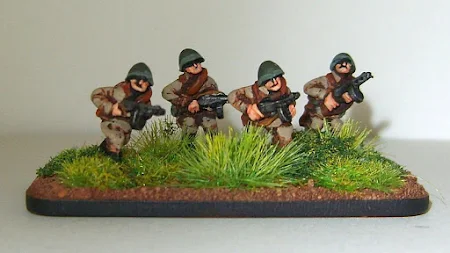So I bought 25 figures and some 2 & 4 mm plain spring tufts. After a few hours work this is a sample of what I'd achieved:

Not the best picture in the world but you get the idea. Of course it's never that simple so the rest of this post covers what I leant.
Groundwork
The texturing went well using my new "almost no paint" method:
- Coat base with PVA.
- Add a few pieces of aquarium gravel.
- Cover remainder with sand and leave to dry for 1 hour.
- Second coat of PVA.
- Sprinkle with medium talus (5 to 10% coverage).
- Cover remainder with sand and leave to dry overnight.
- Paint gravel dark grey and dry bush with light grey then white.
- Wash sand with burnt sienna watercolour wash.
- Leave to dry for at least 2 hours.
- Dry brush sand with VMC 843 Cork Brown.
- Touch up the base edge where necessary.
Watercolour Wash
If you want to make your own wash it's really easy. Just mix tube watercolour and water in a small jar with some stirring beads. This produces a great wash but it needs to to shaken well before use.
Flora
So far so good. The next bit was adding the tufts etc. As I was experimenting I started with a few tufts and small patches of scatter as it's always easier to add than it is to remove.
Adding tufts using tweezers and PVA was very straight forward; no wonder people like using them. I started with 2 or 3, 4 mm tufts per base. Aesthetically, this wasn't enough so I added some 2 mm tufts. This looked better but still artificial. Then I added some patches of regular static grass to roughen the edges of the clumps.
At this point I had plain green tufts and a mixed green/yellow static grass. The contrast was too stark so I dry brushed the tufts with VMC 953 Flat Yellow to tie everything together. The tufts dry brushed really easily. At first I tried dry brushing with a pale cream first but that looked wrong.
I put the bases away and returned to them the next day. With "fresh eyes" I felt the varying heights worked well but the, now consistent, colour of the tufts and static grass looked bland and therefore artificial.
To resolve this I added patches of dark green foam scatter (I can't remember where I got it from) to provide some contrast. As before the initial contrast was too strong so I dry brushed the darker patches with VMC 891 Intermediate Green (to add depth) and VMC 015 to tie everything together.
In future I should be able to do this much more quickly as there'll be a lot less experimentation. I think the method will be:
- 4 mm spring green tufts (2-3 per base)
- 2 mm tufts (but only because I need to use them up).
- Dark green foam scatter.
- Regular static grass.
- Leave to dry.
- Dry brush dark green scatter with VMC 891.
- Dry brush all foliage with VMC 015.
.png)

1 comment :
Link to TMP comments
Post a Comment